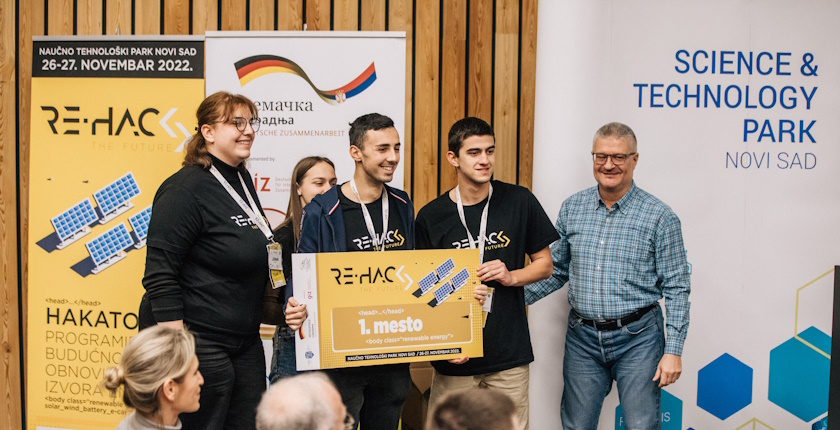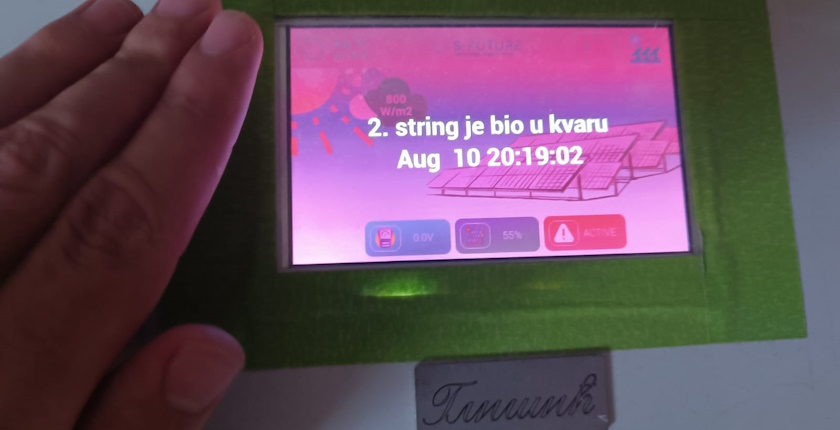
Photo: GIZ
The S-Futur team won the first RE-Hackathon, a competition held within Germany’s development cooperation project Promotion of Renewable Energy and Energy Efficiency in Serbia. It is implemented by GIZ (Deutsche Gesellschaft für Internationale Zusammenarbeit) and the Ministry of Mining and Energy. After attending three workshops with expert lecturers, the participants were given 48 hours to provide a concept and develop software in the renewable energy sources segment with special emphasis on solar energy.
Members of S-Futur, the winning team, spoke to Balkan Green Energy News about their prototype alarm system for solar panels that will notify users of malfunctions, via IoS and Android applications.
The group consists of three undergraduates and one high school student. Luka Glišić is currently in the second year of IT-software engineering studies at the Mihajlo Pupin Technical Faculty in Zrenjanin.
Milica Kovačić and Stefan Miljković are fourth-year students at the Faculty of Technical Sciences in Novi Sad, Serbia’s second-largest city. She is majoring in energy, electronics, and telecommunications while he is in the clean energy technologies department.
Simon Stefanović is the youngest member of the team. He graduated from the third grade of the secondary Technical School in Valjevo.
Milica, tell us more about the hackathon.
RE-Hackathon was organized last year by the Science and Technology Park in Novi Sad under the auspices of GIZ. The event lasted from November 25 to 27. The goal was to find a software solution for issues related to solar energy and solar power plants in 48 hours.
What was the application process like and what are the steps on the way to the finals?
The competition was open for both teams and individuals. The aim was to bring together young individuals with knowledge in electrical engineering and programming, to jointly come up with the best solutions to the problems presented to them. There were nine teams in total, consisting of college colleagues and people who knew each other. Our team was formed by the organizers because each member has registered individually.
None of us knew each other before. We thought it was a shortcoming, but it turned out to be the opposite. A total of ten teams competed during those 48 hours.
The competition consisted of lectures by mentors, joint teamwork as well and consultations with mentors. I want to emphasize that this was one of the best organized events I have ever been to. In addition to very valuable prizes for the first three positions, mentorship was provided for continuing work after the competition.

Stefan, why was it important to prototype an alarm system for solar panels that will notify the user via IoS and Android applications of malfunctions and damages?
The idea was to ensure maximum monitoring of solar power plants and automatize the fault detection process. This means that we strive to reduce losses by reducing the time it takes to detect and correct errors.
Luka, can you tell us more about the functioning of the alarm system for solar panels?
Specifically, my task was to develop a sophisticated software and hardware solution for monitoring and maximizing the efficiency of output from solar panels.
For effective monitoring, I relied on a database that serves as a central repository of all relevant information. This database contains detailed data on the performance, production, and status of solar panels. The use of this medium enabled us to analyze historical data, which is crucial for optimizing system operation and the ability to communicate with other units, be it other systems, telephones, or computers.
We aim for our software to support flexibility and adaptability to integrate with the widest possible range of power plants
Considering the diverse characteristics of each power plant, product customization is necessary. It involves sensor protocols and hardware components in accordance with the specifications of each power plant. Different specifications require different sensors, hardware, and communication protocols, which is why we strive for our software to support flexibility and adaptability so that it can integrate with as wide a range of power plants as possible.
Our alarm and monitoring system constantly tracks and records the production of string electricity at solar power plants. A string is an ordered sequence of symbols, that is, a character data type. This data is continuously sent to a central server for further analysis. The key point was the categorization and detection of irregularities, which is based on the analysis of the amount of electricity produced.

The system is designed to automatically recognize deviations from the expected pattern of production and hardware performances and to generate appropriate warnings by notification to the phone via SMS or through the application.
The application operates in the background, awaiting information on any changes and providing real-time status updates from anywhere. If there is no connection to the internet, it is also possible to do this using an SMS message.
Overall, the creation of this solar power plant prototype required a deep understanding of energy systems, flexibility for different technical requirements, constant performance monitoring, and integration between software and hardware components to ensure maximum efficiency and reliability.
Simon, what are the next steps for your team? Are you planning further development, or any similar projects? Is there interest in the implementation of your prototype?
We will focus on developing and enhancing the prototype. Our team, S-Futur, has high ambitions, aiming to deliver a completely marketable product. We have yet to encounter someone interested in our product. Our prototype was recently completed and we are confident that investors will recognize the advantages of our product themselves once they hear about us.


















Be the first one to comment on this article.